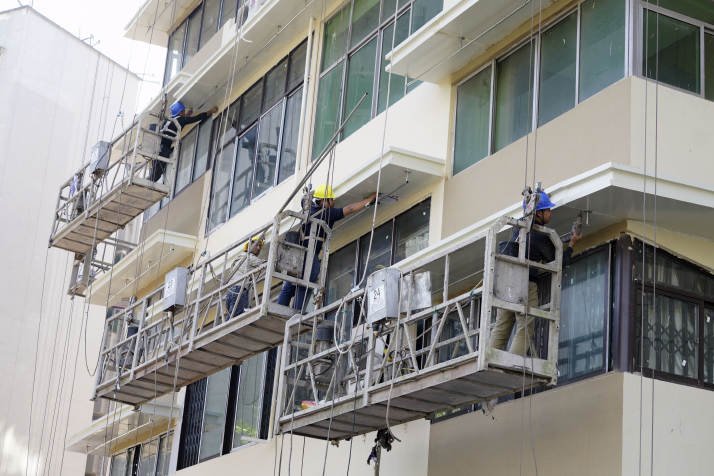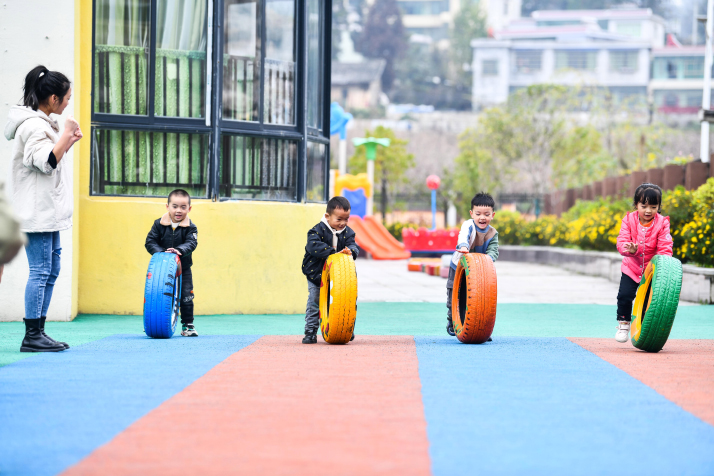| Society |
| Plan for public services expected to substantially improve the wellbeing of people at various stages of life | |
| Public services aim to meet needs for a better life | |
|
|
 Workers renovate an old residential building in Chongqing Municipality on October 23, 2021 (XINHUA)
A person's life is divided into three periods: childhood, adulthood and old age, and a new plan makes arrangement for public services people need in all the three periods. The 14th Five-Year Plan (2021-25) for public services, jointly released on January 10 by 21 government departments, including the National Development and Reform Commission (NDRC), has set new goals in areas such as education, housing and senior care. Ou Xiaoli, Director of the NDRC's Department of Social Development, said at a press conference on January 11 that China has continuously pushed for the improvement of the basic public services and promoted equal access to them through three recent five-year plans. However, he noted that this new plan is the first of its kind to address the provision of non-basic public services. Basic public services are for satisfying people's basic needs for subsistence and development, with the government shouldering the main responsibility for ensuring their provision, whereas non-basic ones are for satisfying people's higher-level needs, according to the plan. The supply of non-basic public services, such as affordable childcare and eldercare, is currently insufficient to meet market demand. The government should be responsible for increasing inclusive supplies of such services through supportive policies, so that the majority of citizens can afford and enjoy them. The plan also pointed out that services aimed at satisfying people's diversified, customized and high-end needs should be provided by the market only, while the government is responsible for creating a fair market environment for such services to guide their healthy development. "People aspire for better education, more stable jobs, higher income, more reliable social security systems and higher-level medical services. They also need more comfortable living conditions and richer cultural lives. Therefore, we need to address the provision of non-basic public services which are broader in range and shorter in supply," Ou said.  (Up) Workers renovate an old residential building in Chongqing Municipality on October 23, 2021 Children play at a kindergarten in Longli County, Guizhou Province, on November 4, 2020 (XINHUA)
All-round assurance The plan has set specific goals for public service provision till 2025. "China plans to add 6.5 million government-subsidized rental homes in 40 key cities to help an estimated 13 million people in need of affordable housing," Pan Wei, an official with the Ministry of Housing and Urban-Rural Development (MHURD), said at the press conference on January 11. The MHURD has made continuous efforts in providing both basic and non-basic public services to improve people's sense of gain, happiness and security. In 2021, 936,000 government-subsidized rental homes were added in 40 key cities. They are expected to accommodate over 2 million people. In addition, he said, "Around 219,000 old residential communities built before the end of 2000 in urban areas will be renovated by 2025 to afford more comfort to the residents." From 2019 to 2021, 114,000 old residential compounds had been renovated, benefiting over 20 million households. Infrastructure for the supply of water, electricity, and natural gas was improved, elevators were installed and parking lots were created to serve these compounds. The ministry also announced plans to repair structurally unsound rural homes and upgrade those in earthquake-prone rural areas. Addressing the growing need for aged care in China is a strong feature of the newly released five-year plan. Li Banghua, Deputy Director of the Department of Elderly Service of the Ministry of Civil Affairs, said at the aforementioned press conference that the plan has addressed more aged care issues than previous plans in order to better cope with new challenges and demands placed on public services by the aging population. The plan has set out requirements for different levels of senior care services in order to satisfy different demands. It emphasized the government should shoulder the main responsibility for providing basic eldercare services such as accommodation and medical care to people with disabilities, those living on government allowances and impoverished people, for free or at low charges. For other seniors, the plan stipulated that the government should support the increase of inclusive aged care services and encourage private enterprises to take part in their provision. Training of aged care service staff should also be strengthened to provide better services to seniors. For higher-end services, the plan proposed promoting the integrated development of the senior care industry with related service industries and pushing the development of these enterprises to form chains and corporations, to bring strength and efficiency to the sector. According to the plan, the total number of beds in senior nursing homes will reach 10 million in 2025. That year, 100 percent of newly built urban areas and residential communities will feature supporting facilities, and coverage of basic old-age insurance will reach 95 percent. The development of higher-quality and fairer education is yet another of the plan's main tasks. Changes to China's family planning policy mean couples are now allowed to have three children. To address the expected higher birth rate, new kindergartens will be built and existing ones renovated and expanded across urban areas with increasing populations, as well as in rural areas. Funding for preschool education will be increased and kindergarten teachers' income and welfare improved to lift the quality of preschool education. The balanced development of compulsory education, too, will be promoted during the 14th Five-Year Plan period. The educational gaps between regions, urban and rural areas, and schools will be narrowed. The capacity of basic public education facilities should match the permanent population in a particular area. The plan has also laid out measures to increase stability and sustainability of public services aimed at improving people's livelihoods and clarified the roles of different entities in providing public services. It also stated that the provision of basic public services should be tailored to match social and economic conditions and local governments should evaluate risks before increasing the number or improving the standards of basic public services according to their financial capabilities. (Print Edition Title: Full Coverage) Copyedited by G.P. Wilson Comments to jijing@cicgamericas.com |
|
||||||||||||||||||||||||||||||
|